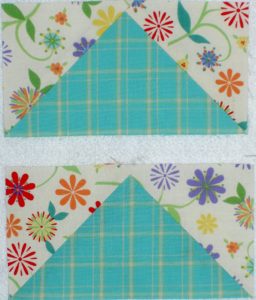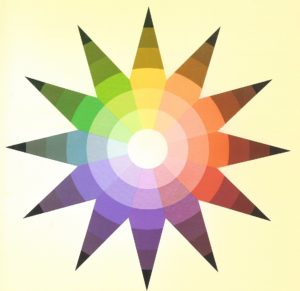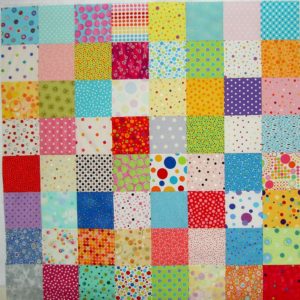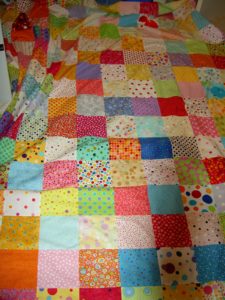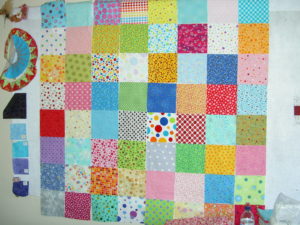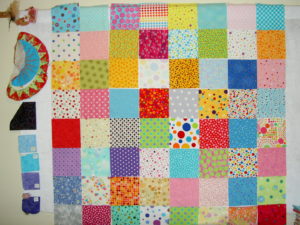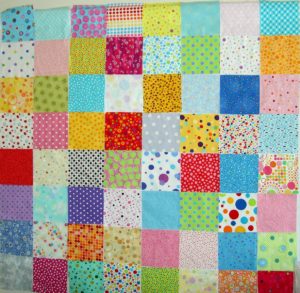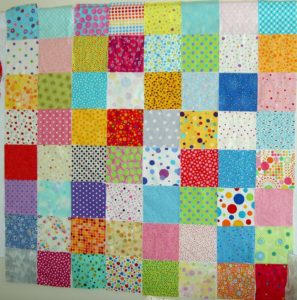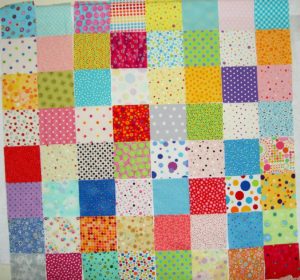Serendipity Puzzle is my new project. It uses the latest group of Piece O’ Cake fabrics, called Serendipity, plus some of the woven plaids from their 4th plaids collection. The plaids I am using are POCP 437G, POCP 437O, POCP 437R, POCP 437T, and POCP 437Z. I bought these fabrics in June at Quilting Adventures during my trip to Maryland and Virginia.
This project is a follow-up to Thoughts on Dots as I am still using color and giving myself some limits (using, basically, one line of fabric). This time however, I am doing more piecing. Initially I am finding that piecing blocks allows me to sew a few seams, even if I have only a few minutes, thus making progress. Thoughts on Dots required larger blocks of time for the staring and arranging part as well as once I started sewing. Neither is bad, just different. It is satisfying to be mindful of the process.
P&B offered a free pattern for this line of fabric, which I liked and provided inspiration. Ultimately, however, I decided not to use it. I am doing a variation on the triangles theme from the free pattern but using the Dutchman’s Puzzle design. I think the Dutchman’s Puzzle pattern is more organized than the pattern they offer. The free pattern has a nice look, just not for me at this time. I guess I need order in my life!
I plan to use the turquoise for the sashing and borders like P&B/Piece O’ Cake does, but am thinking of slight variation. Stay tuned for more info as that part of the project develops.
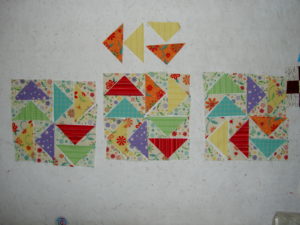 In the above photo you can see that I have cut and selected some of the fabrics in preparation for piecing.
In the above photo you can see that I have cut and selected some of the fabrics in preparation for piecing.
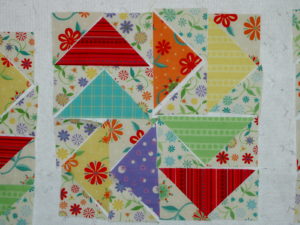 Above is a detail of the center block.
Above is a detail of the center block.
Several days pass….
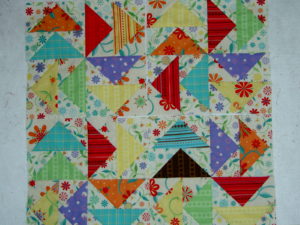 On and off since the second week of November, I sewed a few seams as time permitted, steadily making progress. I don’t plan on setting the blocks this way, but wanted to see how they would look together. This also allows me to review the use of fabric and identify any problems that may be developing. As you can see, I have several blocks and have still not used all of the fabrics from the line. I flipped over the stack of fat quarters so I would cut some new ones the next time I cut the larger triangles.
On and off since the second week of November, I sewed a few seams as time permitted, steadily making progress. I don’t plan on setting the blocks this way, but wanted to see how they would look together. This also allows me to review the use of fabric and identify any problems that may be developing. As you can see, I have several blocks and have still not used all of the fabrics from the line. I flipped over the stack of fat quarters so I would cut some new ones the next time I cut the larger triangles.
Some issues I want to work through with this piece:
1. Distribution of the red: I think that the red is necessary, at least at this point in the piece, but it seems to be a bit dominant, so I need to take care where I place it. I also want to use different reds. There are 3 or 4 in this group.
2. Mixing up the various prints: I need to think about whether to place duplicates of fabrics in one block or to ensure that all the blocks have different fabrics. This depends on the number of different fabrics that I cut as well as similar colorways in different patterns.
3. Brown: I am afraid that the brown will be a dark hole, but like the chocolately feel of it. I may, in the end, take it out (yes, that means unsewing), but I want to wait to see how it looks when I have more blocks.
4. Number of blocks: I am not sure. I think I will make at least 9 and possibly 16. I am thinking that this will be a baby quilt for a friend. We will see.
5. Variation in blocks? : I am thinking about mixing 1-3 regular pinwheels in with the Dutchman’s Puzzle blocks to add interest. I may make a couple just to see how they look. As Lorraine Torrence says in her design classes “Make visual decisions visually.”
